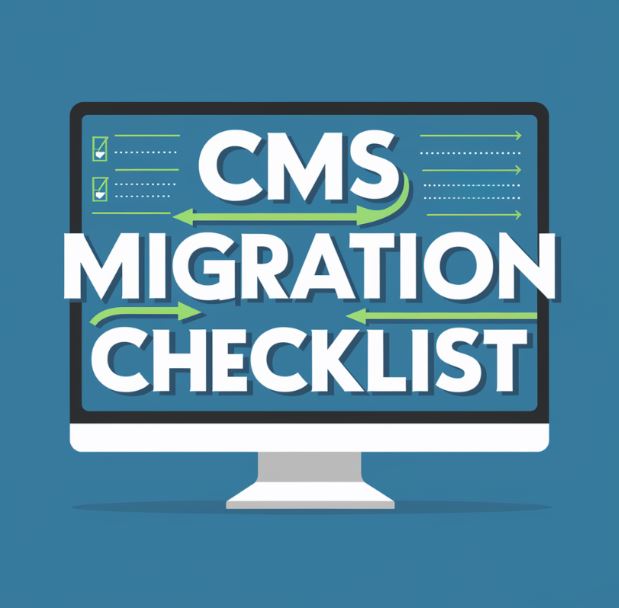You pour hours into ad copy that barely nudges your conversion rates. Most marketers miss simple shifts that make all the difference in landing page optimization. This post breaks down how to write high-converting copy, covering audience understanding, crafting...
The Ultimate Checklist for a Successful CMS Migration

Categories
You may also like…
Essential Best Practices for Mobile Website Performance
Most websites lose over half their visitors because pages don't load quickly or navigation feels clunky on phones. If your site isn't built with mobile optimization in mind, you're missing out on traffic and better rankings. This post breaks down simple steps like...
Harness the Power of Social Media Advertising for Black Friday Promotions
Black Friday marketing can make or break your holiday sales. Many small businesses miss key chances because their email campaigns and website aren't ready for the rush. This post breaks down simple marketing tips, like timing urgency-driven offers and boosting social...
A robust and efficient content management system (CMS) is the foundation of a thriving online presence. While your current CMS may have served you well, as your business grows and your digital needs evolve, you might find yourself outgrowing its capabilities. This is where a CMS migration comes in, offering the chance to unlock new levels of functionality, performance, and security, ultimately allowing you to better engage your audience, expand your reach, and drive growth.
This comprehensive guide will take you step-by-step through the process of migrating your website from one CMS platform to another. We’ll cover everything from identifying the need for a migration to planning your strategy, executing the technical aspects, and optimizing your new platform for success, ensuring a smooth transition that delivers tangible results.
Understanding the Need for a CMS Migration
The decision to migrate your website to a new CMS shouldn’t be taken lightly. Several key indicators suggest that your current system might be holding you back, hindering your ability to reach your full potential:
Outgrowing Your Current Capabilities: As your business expands, your content needs become more complex. You might find yourself battling limitations in your current CMS, leading to difficulty implementing new features, managing a growing volume of content, or handling increased website traffic efficiently. These signs indicate that your current CMS might be hindering your growth potential. Perhaps you’re struggling to integrate essential third-party tools, find it difficult to manage a rapidly expanding content library, or experience frequent crashes and slow loading times due to the system’s inability to handle increased traffic. These are all red flags that your current CMS might be a bottleneck to your progress.
The Need for Enhanced Functionality and Features: New CMS platforms are constantly evolving, offering a treasure trove of features that can enhance your website’s capabilities and user experience. These features can dramatically transform how you engage your audience, optimize your content, and drive conversions. Imagine having access to advanced SEO tools that help you optimize content for search engines, improve visibility, and drive organic traffic. Picture robust e-commerce capabilities that allow you to manage online sales, process payments securely, and offer a seamless shopping experience. Envision user-friendly content management interfaces that make it easier for your team to create, edit, and manage content efficiently, and powerful analytics dashboards that provide in-depth insights into website performance, user behavior, and content engagement, enabling you to make data-driven decisions. Migrating to a CMS that offers these advancements can empower you to create a more engaging and effective online presence, reaching a wider audience and maximizing your marketing efforts.
Prioritizing Security and Performance: Security and performance are paramount to a successful website. If your current CMS falls short in these areas, it’s time for an upgrade. Outdated CMS platforms can be susceptible to security breaches, leaving your website and sensitive data vulnerable to hackers. Additionally, slow loading times, frequent crashes, or other performance issues can lead to frustrated users, lost revenue, and a damaged reputation. Migrating to a newer CMS with robust security features and improved performance capabilities can protect your website and ensure a smooth, reliable user experience, fostering trust and loyalty among your visitors.
Planning Your CMS Migration Strategy

A successful CMS migration is more than just moving your website; it’s a strategic project that requires meticulous planning and execution.
Defining Your Goals and Objectives: Before diving into the technical details, take the time to clearly define your goals and objectives for the migration. What do you hope to achieve by switching platforms? Do you want to improve SEO performance, enhance user experience, streamline content management, boost website speed and performance, or improve website security? Be specific and concrete about your desired outcomes. For example, do you want to increase organic traffic by 20%, reduce page load times by 30%, or implement a seamless online store integration? Having clear goals will guide your decision-making throughout the migration process, ensuring it aligns with your overall business objectives and leads to tangible results.
Research and Evaluate CMS Options: The CMS landscape is vast, with numerous platforms catering to different needs. Conduct thorough research to identify the best fit for your business. Consider factors like features and functionality, scalability, security, ease of use, community support, and cost. Don’t just read reviews; consider conducting pilot projects or requesting demos to get a hands-on feel for different CMS options and assess their suitability for your specific needs.
Assemble a Dedicated Migration Team: A successful migration requires a dedicated team with diverse skills and experience. The team should include a project manager to oversee the entire process, a content strategist to manage the migration of website content, a developer to handle technical aspects, an SEO specialist to optimize the new website for search engines, and a QA tester to thoroughly test the migrated website before launch. Clearly define roles and responsibilities to ensure everyone is on the same page, working together seamlessly to achieve your shared goals.
Develop a Detailed Project Timeline: A comprehensive timeline is essential for keeping the migration process on track and preventing delays. This timeline should outline key milestones, deadlines, and responsibilities for each phase, allowing for proactive planning and management. It should include phases for migration preparation, data migration and content transfer, website design and development, testing and quality assurance, deployment and launch, and post-migration optimization and maintenance. Be realistic in your estimates, accounting for potential challenges and unforeseen circumstances. Regularly review and adjust the timeline as needed to ensure you stay on track and meet your goals.
The Technical Execution
Once you have a solid plan in place, it’s time to delve into the technical aspects of the migration.
Data Migration and Content Transfer: This is a critical step, requiring careful attention to detail to ensure accuracy and prevent data loss. You need to transfer all your website’s content and data to the new CMS platform, including content (website pages, blog posts, product descriptions), images and media, database information, and plugins and extensions. The process typically involves exporting data from the old CMS, importing it into the new CMS, mapping data fields, and validating data integrity. This is a delicate process, so meticulous attention to detail is essential to prevent data loss or inconsistencies. It’s best to conduct thorough testing during this phase to catch any errors or omissions early on, minimizing potential headaches later in the migration process.
Website Design and Development: With your content and data safely migrated, it’s time to focus on the design and development of your new website. This step involves creating a new look and feel for your website that aligns with your brand identity and user experience goals, building the website using the new CMS platform, and tailoring the website to meet your specific needs, such as adding custom features or integrating with third-party services. This phase requires collaboration between designers and developers to create a website that is both visually appealing and functionally robust. Clear communication and a shared vision are key to ensuring a successful outcome.
Testing and Quality Assurance: Before launching your new website, it’s crucial to test it thoroughly to identify and fix any errors or bugs. This testing should include functionality testing, content testing, performance testing, and security testing. Thorough testing is essential to ensure a smooth launch and prevent issues that can impact user experience and website performance.
Deployment and Launch: Once you’ve completed all necessary testing and are confident in the stability of your new website, it’s time to launch. This involves making the website live on the internet, redirecting traffic from your old website to the new website, and monitoring the website’s performance after launch. This phase requires careful planning and execution to ensure a seamless transition for users and minimal downtime. Consider a phased rollout approach, gradually introducing the new site to users to test its performance and identify any potential issues.
Post-Migration Optimization and Maintenance
The migration process doesn’t end with the launch of your new website. Ongoing optimization and maintenance are crucial for its continued success.
SEO Optimization: A CMS migration can have a significant impact on your website’s SEO performance. You need to ensure that your new website is optimized for search engines to maintain or improve your search visibility. This includes optimizing URL structure, meta descriptions and title tags, image optimization, link building, and content optimization. Stay up-to-date with the latest SEO best practices and make adjustments to your website’s content and structure as needed to maintain your ranking and reach a wider audience.
User Experience Enhancement: A successful CMS migration should enhance your website’s user experience. This means making it easier for users to navigate your website, find the information they need, and complete their desired actions. You can enhance user experience through website navigation, content layout and design, mobile optimization, and accessibility. Focus on creating a seamless and intuitive experience for your visitors, making it easy for them to find what they need, explore your website, and engage with your content.
Ongoing Monitoring and Maintenance: Once your website is live on the new CMS platform, you need to monitor its performance regularly to identify and address any issues that arise. This includes monitoring website uptime, website speed, website security, and staying up-to-date with the latest CMS updates. Regularly check for broken links, outdated content, and security vulnerabilities to ensure your website remains a reliable and trustworthy resource for your visitors.
Common Mistakes to Avoid During a CMS Migration

A CMS migration is a complex project, and it’s easy to make mistakes if you’re not careful. Avoid common pitfalls like lack of planning and preparation, insufficient testing and QA, underestimating the complexity of the project, and neglecting SEO considerations.
Tips for a Smooth and Seamless CMS Migration
Following these tips can help you make the CMS migration process smoother and more successful:
- Establish Clear Communication: Keep all team members, stakeholders, and clients informed about the migration’s progress, potential challenges, and expected timelines. Regularly communicate with everyone involved to keep them informed and ensure everyone is on the same page.
- Prioritize User Experience: Ensure that the new website is easy to navigate, visually appealing, and provides a positive experience for users. Think about the user journey from the perspective of your target audience and ensure they have a smooth and enjoyable experience navigating your website.
- Document Every Step: Document decisions made, challenges encountered, and solutions implemented during the migration process. This documentation will be invaluable for future reference, troubleshooting, and potential future migrations. Documenting your process can also help you identify areas for improvement and streamline your approach for future projects.
- Embrace Flexibility and Adaptability: CMS migrations are rarely straightforward. Be prepared to adjust your plans and adapt to unforeseen challenges. Flexibility and adaptability are essential for ensuring a successful migration. Be prepared to pivot when necessary and embrace the unexpected, as these situations often lead to creative solutions and valuable learning experiences.
Conclusion: A New Era for Your Digital Presence
A successful CMS migration can transform your online presence, opening doors to new opportunities for growth and success. It enables you to enhance your website’s functionality and features, improve its performance and security, streamline content management processes, and boost your website’s SEO performance. The result is a more engaging and effective online presence that resonates with your audience and drives real results.
However, navigating the complexities of a CMS migration requires expertise and experience. Partnering with experienced digital marketing professionals can ensure a smooth and successful transition, minimizing downtime and maximizing the benefits of your new CMS platform. They can provide the technical expertise, strategic insights, and ongoing support you need to navigate the intricacies of the migration process and ensure your website is set up for long-term success.
By investing in a well-planned and executed CMS migration, you’re not just upgrading your website; you’re investing in the future of your digital presence. It’s a strategic move that can propel your business forward and help you achieve your online goals, reaching a wider audience, boosting your brand visibility, and driving meaningful growth.



